Does flooding pose a risk in your area? If so, what can you do to protect your home from flooding? Does homeowners insurance cover flooding? How many sump pumps do you need? How do you prevent water from entering your home? Can you protect your home from flooding on your own?
Fortunately, property owners have options. Homeowners can take plenty of preventive measures to protect their homes from flooding. We’ve compiled a guide of all the information you need about the importance of proper drainage, tips to prevent flooding in your home and how to find flood insurance in Missouri.
Jump To:
Are you at a high risk of flooding in your area? Can your home withstand a flood? Check out the FEMA Flood Map if you’re unsure about your area’s flood risk.
The height floodwaters can rise due to inclement weather is the flood level— ideally, your property would sit above this. But sometimes, our homes aren’t in ideal locations. Your property might be at the bottom of a hill or valley, and your risk of flooding could be higher than your neighbors’ homes built uphill. More water will flow to your home, putting you at a higher risk.
But no matter where your property is, proper drainage from your home is crucial. Adequate drainage can prevent flooding in or around your home. Property damage due to flooding can be both costly and devastating, so ensuring your property has a well-functioning drainage system is critical to protecting your home from flooding.
The goal is to stop floodwater from entering your home, but you also want a backup plan if it does. Water should have a clear pathway to leave your property, and that’s where a drainage system comes in.
So how do you prevent flooding in your home? Flood-proofing your property can include costly home renovations or free, easy maintenance. The prevention measures you put into place will depend on the risk your home faces when it comes to flooding and how well your home’s construction can withstand floods.
Remember, natural disasters and flash floods aren’t the only causes of a flooded home. Homes can flood due to a broken water main, leaky pipes, appliance malfunctions and other household problems. To help you do the most to protect your home, we’ve compiled a list of several tips you can follow to learn how to prevent water from entering your home.
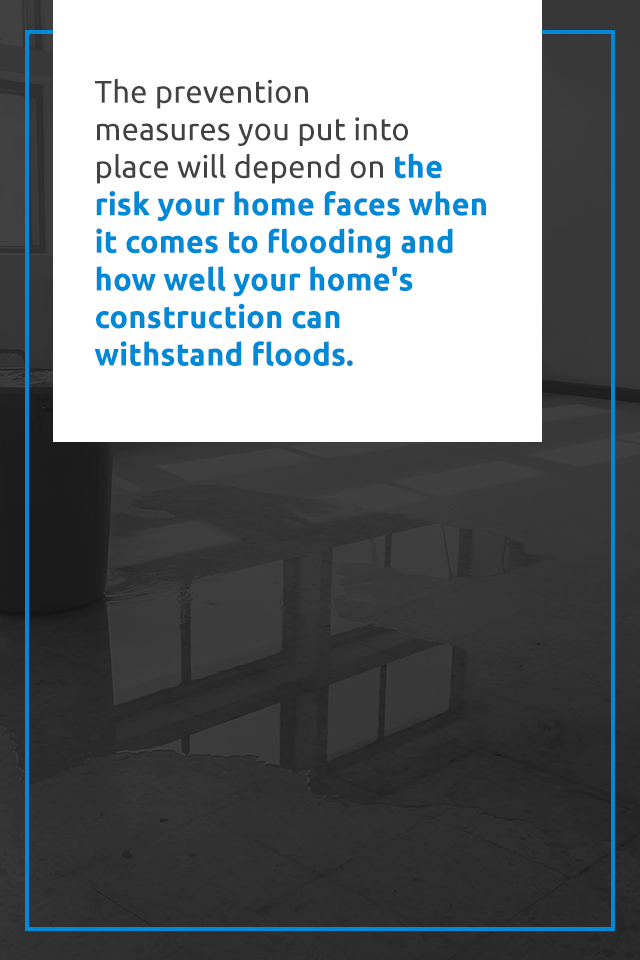
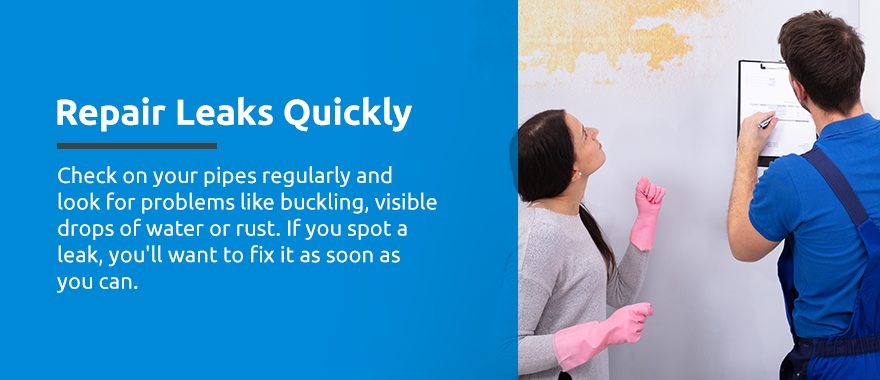
If you’re a homeowner, you may have had to deal with a leaky roof or pipe at some point. Sometimes we put off this maintenance, thinking it’s a minor issue we don’t need to take care of immediately. But a leaky roof or pipe can cause quite a bit of damage.
Look for water pooling in the basement or wet spots on your ceiling — these are telltale signs of a leak. Check on your pipes regularly and look for problems like buckling, visible drops of water or rust. If you spot a leak, you’ll want to fix it as soon as possible.
When your property experiences a large amount of rainfall or snowmelt, evaluate the runoff to determine how floodwaters might enter your home. Does the runoff flow toward your home or away from it? Are there specific doors or basement windows where the water collects? Analyzing how runoff moves on your property will help you better understand the risks of flooding you may face and which areas of your property you should target with your preventive measures.
Sump pumps work by pumping water out of basements, where flooding often occurs, and transporting it outside. To remove water from your home, ensure your sump pump functions correctly. You’ll need to have it serviced twice per year. Many homeowners ask, “Do I need two sump pumps?” We recommend learning how many sump pumps you need and determining if that is the best solution for your home.
We also recommend having a battery backup for your sump pump, so you can still use it even if your power goes out. Power outages tend to accompany severe storms, but with a battery backup, you can pump floodwater out of your basement when you don’t have power.
Foundation vents are an alternative solution to a sump pump. These vents allow water to flow through your house instead of collect around it, which means the floodwater will have an outlet and less pressure on your walls and any basement windows.
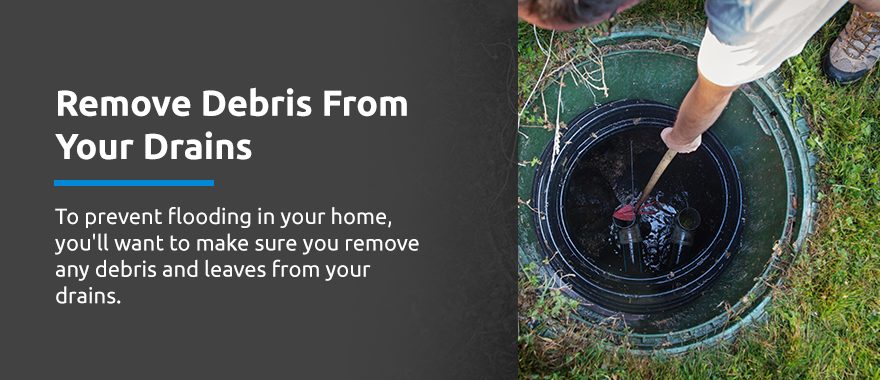
To prevent flooding in your home, you’ll want to remove any debris and leaves from your drains. Rake the leaves and sticks in your yard and place the waste in a container or leaf bag. You’ll want to use a broom or rake to remove the debris and leaves from your storm drains. You can then place that material in your receptacle for yard waste.
Can’t remove the debris on your own? Hire a professional to tackle the job for you.
Twice a year, clean your gutters and remove leaves. At that time, you should also clean the drainage downspouts that attach to your roof. A single storm can quickly clog up your usually well-functioning drainage system, so you’ll want to make sure you’re keeping up with regular maintenance. You can also install leaf guards, preventing debris from building up.
Remember to inspect your rain gutters for leaks or damage, which can cause flat roofs to flood. Without discharging flow to adjacent properties, direct the flow from your downspouts away from the foundation. If the water pools at corners of your home, you might end up dealing with leaks in your basement. Consider installing downspout extenders, which can direct water 10 feet away from your home. You’ll also want to avoid discharging water over a steep hill.
Make cleaning out your gutters part of your fall and spring routines so you won’t forget it.
You can maintain your drainage systems by clearing the drains and ensuring there aren’t any blockages. On private property, maintaining the drainage system becomes your responsibility as a homeowner.
For a commercial property owner, checking the drainage system is especially critical if you have catch basins or similar drainage systems. Hire a professional to video inspect the underground drainage system so you can find out what’s in the pipes.
You’ll want to clear the drain at the bottom of the incline for driveways that lead down from the road. For properties located on a cliff or the base of a hill, you’ll want to check that your retaining walls and drainage are functioning correctly.
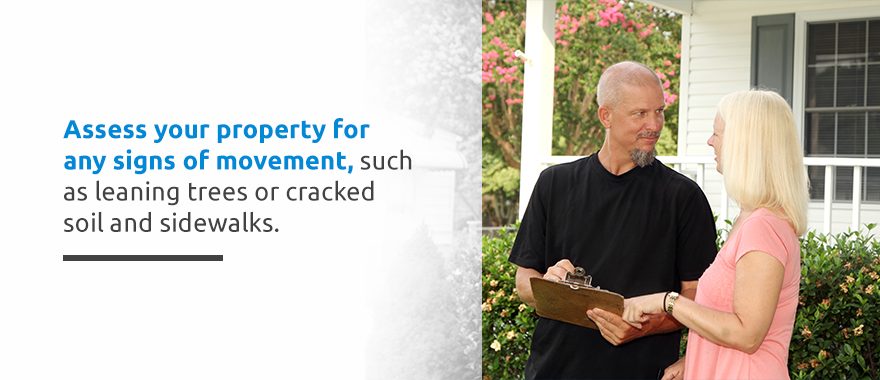
To prevent flooding in your home, you’ll want to remove any debris and leaves from your drains. Rake the leaves and sticks in your yard and place the waste in a container or leaf bag. You’ll want to use a broom or rake to remove the debris and leaves from your storm drains. You can then place that material in your receptacle for yard waste.
Can’t remove the debris on your own? Hire a professional to tackle the job for you.
Seal cracks in your foundation to prevent water from entering your home through any cracks. Purchase masonry caulk or mortar to complete the job and fill in those gaps. If the problem seems to persist, you may want to seek a more permanent solution.
You’ll also want to seal cracks in your walls, windows and doors. To do this, apply sealants and coatings, which you can find at most hardware stores and home retailers. You can’t stop the rain, but you can minimize the number of entry points that allow water to leak into your home.
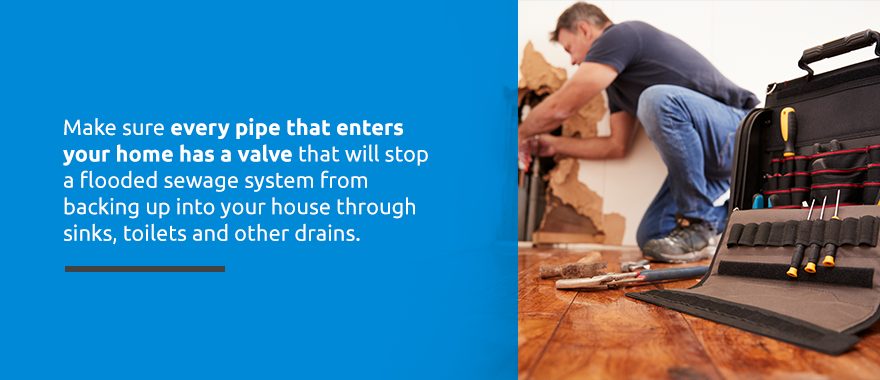
The last thing you want to worry about in a flood is your sewage system backing up. To prevent this, ensure every pipe that enters your home has a valve that will stop a flooded sewage system from backing up into your house through sinks, toilets and other drains.
Opt for a gate valve rather than a flap valve, as they provide a more robust seal against the pressure of a flood. You can have these professionally installed or make them a DIY project. You may also want to install drain plugs for all your basement floor drains to prevent sewer backups.
Runoff can cause flooding on your property, so your goal is to reduce it as much as possible. You can collect rainwater in cisterns and barrels, otherwise known as rainwater harvesting.
You may also want to consider establishing a rain garden. Rain gardens absorb, collect and filter rainwater runoff from driveways, rooftops, patios and other areas that don’t allow water absorption.
Other options involve using permeable pavement instead of concrete or asphalt or growing a green roof. Green roofs provide the added benefit of extending the life of your roof’s materials, as they block UV radiation and stabilize extreme temperatures. These roofs slow rainwater runoff, provide attractive greenery and reduce the costs of heating and cooling your property.
If you want to get your home above the flood level, you can raise your home with stilts. Simple, right? Even retroactively, it’s doable, but it’s an expensive renovation. Even an inch of water can significantly damage your home, costing more than $25,000. Raising your property above the flood level will significantly increase your home’s protection from flooding.
If you are building a home in a flood-prone area, consider including piers or stilts in your design plans before construction occurs. These will save you the hassle of conducting the renovation retroactively.
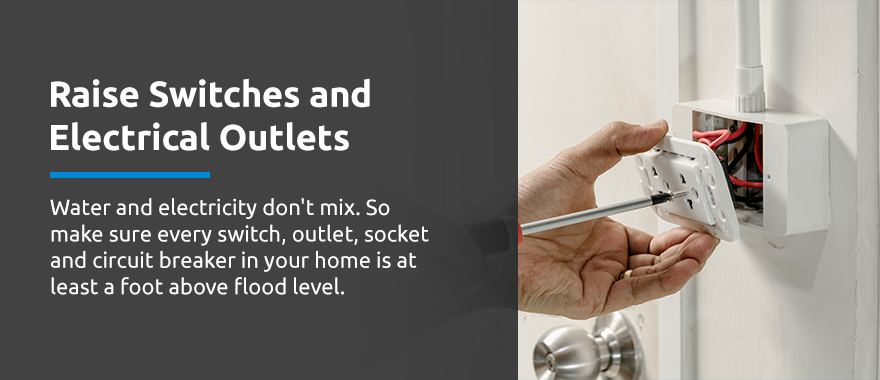
Water and electricity don’t mix. So ensure every switch, outlet, socket and circuit breaker in your home is at least a foot above flood level. Doing so will prevent electrical damage if your home floods.
Put both internal and external appliances above the flood level. You may accomplish this by elevating these items on concrete blocks. A few appliances to elevate include:
You might also wish to include expensive or sentimental items in this process as well. In a home with two or three stories, you can move your valuables to one of the higher floors to help protect them in case floodwaters ever reach your first floor.
A house’s siding can rot when exposed to wet mulch, and this rotting leads to leaks. By creating a space between your siding and mulch, you’ll ensure the base of your home remains completely dry after a rainstorm.
Does your yard tilt toward your home? If so, water will collect around your house. You can use heavy soil containing sand and clay to regrade your lawn. Doing so will allow surface runoff to empty into a better spot, like a street gutter. You can hire a professional if you’re unsure how to grade your lawn.
Because basement window wells tend to trap groundwater and rain, you’ll want to invest in window well covers for added protection, even if your windows are newer. The process of covering the window wells is straightforward and affordable. Your basement will also receive lots of light if you choose covers made of clear acrylic.
Aggressive tree roots can harm your foundation and make your house susceptible to flooding. You will probably want to plant more troublesome trees farther from your home, at least 10 or 20 feet away. These trees include white firs, maples and aspens. If you have a damaging tree that is too close, you may want to consider having it removed.
Most home security companies allow you to include flood sensors as an add-on. These sensors detect small leaks, so you can tackle the problem before it can cause any significant damage to your home. You may want to install a flood sensor for a little peace of mind and the possibility of saving thousands of dollars.
Additionally, you may want to keep your valuables in locked containers. You can place your essential documents in a waterproof case, such as a birth certificate and passport. Vessels designed to withstand flooding are a better option than Ziploc bags.
To prevent water from entering your home, you’ll want to flood-proof your property and ensure you have protected all your belongings against water damage.
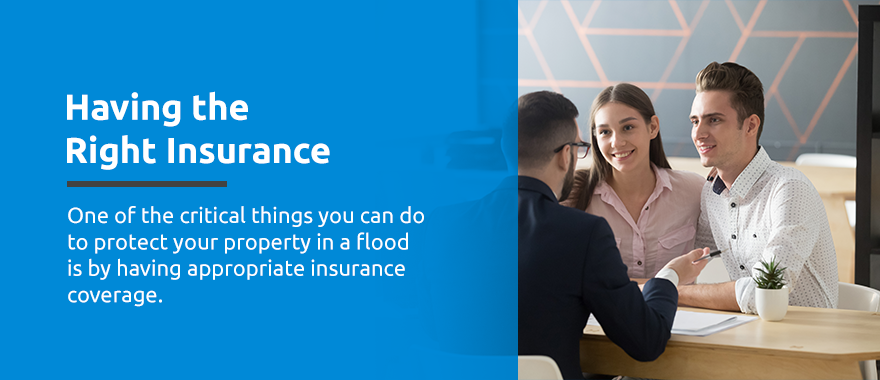
One of the critical things you can do to protect your property in a flood is to have appropriate insurance coverage. You may be wonder, “Does my homeowners insurance cover flooding?” Even though floods are a leading cause of home damages, standard homeowners insurance does not cover flooding, so you’ll want to purchase an additional flood insurance policy to protect you.
You don’t need to be a homeowner to have flood insurance. You can also obtain flood insurance if renting a property to protect your belongings. If you live in a low-risk zone, you may still want to purchase flood insurance. Anyone can be vulnerable to floods. Even if your area has never experienced a flood, that doesn’t mean one isn’t possible.
Water backup insurance may be the right choice for your home as well. This insurance covers you if water or sewage backs up into your home from a drain, sewer, sump pump or related equipment. This type of insurance is not the same as flood insurance, but could be an alternative to protect you from water damage in the case of an unforeseen sewage backup.
Flood history is only one of the factors that play a role in determining a region’s flood risk. Other factors include topography, rainfall data, river flow data, tidal surge, wind velocity, flood control measures, community maps and building development, both existing and planned. You’ll be happy you have insurance to cover you rather than relying on a loan you’ll have to repay with interest.
Floods can result from poor drainage systems, broken water mains, heavy rains and rapid accumulation of snowmelt. Most homeowners and renters are vulnerable to these causes of floods, so keep yourself protected by having the right insurance.
Floods are the most expensive natural disaster in the U.S. If you live in a flood-prone area where you can’t avoid this issue, obtaining flood insurance is critical. If you face flood damages and without flood insurance, you may be unable to afford the costs of repairing or rebuilding. More than a quarter of the claims from recent Missouri flooding have been in areas that aren’t at a high risk of flooding.
Though costs for flood insurance do depend on your flood risk, the average cost of flood insurance for homeowners in Missouri is just $1,000 per year. Coverages can range from $100,000 to $500,000 depending on the size and use of your structure, whether residential or business. For moderate- to low-risk areas, you can select between building coverage and contents coverage.
Flood insurance will cover your house’s foundation elements and equipment that supports the structure, such as the circuit breakers, water heaters, furnace and more. Compare what you can expect from building coverage vs. contents coverage when deciding whether you want to add contents coverage to your building coverage. Contents coverage typically includes items like your washer and dryer units, your freezer and the food inside.
Act today to get the home flood protection and Missouri flooding solutions you need.
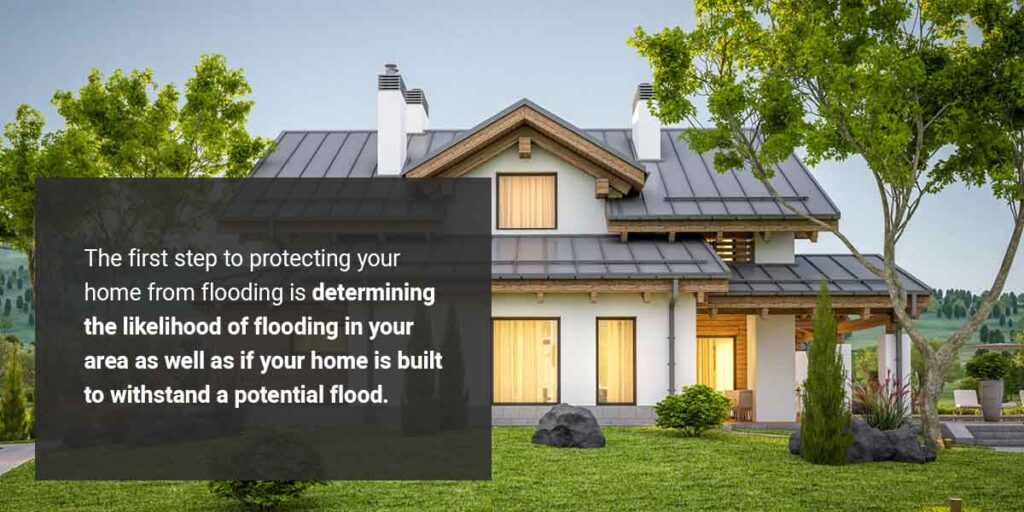
The first step to protecting your home from flooding is determining the likelihood of flooding in your area as well as if your home is built to withstand a potential flood. FEMA has a flood map service that shows a general flood risk based on your region. All you have to do is enter your address and press enter, and you’ll see the flood zones in your area.
This map uses number markings to indicate the risk of flooding in a given area and specific structures, such as dams, levees and bridges. Some of the flood zones you might see on this map include the following:
When viewing the FEMA map to look at the flood zone, you’ll want to note the year the map was made. Some maps are significantly out of date and don’t show accurate information. The flood information might not indicate the actual risk, so you’ll want to find the most recent map possible.
You can also work with your flood insurance provider to determine the specific level and risk to your home, allowing you to choose a policy that offers the best coverage. Homes below the flood level have a higher risk of flooding than those above, such as homes built in a valley instead of a mountain.
Now that you know how to protect your home from flooding, you can look for a flood insurance policy. David Pope Insurance Services, LLC, has provided insurance in the greater Union and St. Clair areas for more than 15 years. We know our clients have different insurance needs, so we aim to provide flexibility in the coverages we offer. This versatile approach has made us one of the most respected insurance providers in the state.
We’ll work together to give you the coverage you need at the most affordable premium. We know finding the right insurance can be overwhelming and stressful, and that’s why we strive to make it a smoother process for citizens in Missouri. We’re proud and excited to serve our clients every day. We serve residents within a 25- to 30-mile radius of our Union location, including Washington, Villa Ridge, Sullivan, Saint Albans, Robertsville, Labadie and more.
To obtain flood insurance in Missouri, call us at 636-583-0800 or contact us today.